Translate this page into:
Groundwater contamination with the threat of COVID-19: Insights into CSR theory of Carroll's pyramid
⁎Corresponding authors. afzaldar@sust.edu.cn (Afzal Ahmed Dar), ahsanklasra@zju.edu.cn (Ahsan Nawaz), ahsanklasra@gmail.com (Ahsan Nawaz),
-
Received: ,
Accepted: ,
This article was originally published by Elsevier and was migrated to Scientific Scholar after the change of Publisher.
Peer review under responsibility of King Saud University.
Abstract
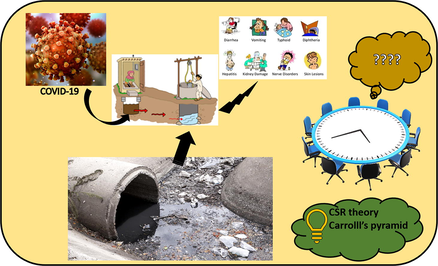
Abstract
In this study, we elucidated the effect of sewage drain on groundwater contamination as including different contaminants, microbes, and pathogens, which deteriorating the groundwater by poor infiltration and seepage. This is getting severer in developing countries like India, Bangladesh, and Pakistan, where unprocessed effluent is discharged into the water bodies. This study was planned to elucidate the effect of sewage drain (based on distance 0–5, 5–10, 15–20, 20–25 m) from two different sewage drains to explain the different physiochemical, and biological parameters including total soluble solids (TSS), chloride, total dissolved solids (TDS), calcium, total hardness, magnesium, nitrate, chemical oxygen demand (COD), dissolved oxygen (D.O.), and biological oxygen demand (BOD). Drainage channel number-1 results showed that E. coli (positive), coliform count (22.75–48.66 /100 mL), and BOD (8–25.75 mgL−1) remained above the permissible limit of the World Health Organization (WHO). Besides, drainage channel number 2 results exposed that E. coli (positive), coliform count (17.7–47 /100 mL), and BOD (6.25–21.5 mg/ L) was not within the permissible limit of WHO. The presence of COVID-19 in the stool has been significantly reported in the literature. The presence of stool in sewage drain leading to groundwater contamination can be an emerging threat to water pollution and could lead to the spread of COVID-19. This study helps to minimize this threat with the help of corporate social responsibility (CSR). Because organizational responsibility towards its society is one of the critical factors to contain numerous issues related to the society.
Keywords
Groundwater
Biological fecal contamination
COVID-19
CSR theory
1 Introduction
Water is a basic necessity of life, an inevitable resource available underneath the surface, and in soil pores, not the only constituent of life (Ferrer et al., 2020). Water contamination contributes to bacteria and pathogens, significantly causing waterborne diseases (WBDs). Recently, the WHO reported that 1.4–4.0 Million (M) patients suffer from cholera, and about 2.1–14.3 thousand death per year worldwide (Prüss-Üstün et al., 2016). Besides, 25% of the world doesn't have access to clean microbe-free drinking water, and this figure multiplies (above 50%) in Africa (Bain et al., 2014; Nowicki et al., 2019).
The WBDs are very significant and ubiquitous, even in developed countries. (Murphy et al., 2014). WBDs mainly occurs by ingestion of contaminated water by microorganisms. There are 13 diseases which can be count for epidemic outbreak, including campylobacteriosis, cryptosporidiosis, acute otitis externa, Legionnaires' disease, free-living ameba infection, Escherichia coli (E. coli) infection, hepatitis-A virus (HAV) infection, nontuberculous, giardiasis, mycobacterial (NTM) infection, septicemia or Pseudomonas-related pneumonia, cholera, shigellosis, vibriosis, and salmonellosis (WHO, 2015). In research from Punjab, Pakistan, has elucidated that 90% of households were anguish from WBDs. This research further reported that 32%, 17%, 13%, 11%, 9%, and 8% from malaria, dysentery, skin disease, typhoid, cholera, and diarrhea, respectively (Jehangir et al., 2000). The majority of the Pakistani consume groundwater without remediation/treatment, and their parameters are not fit for drinking purposes, and it may have adverse effects on health (GOP, 2000; Raza et al., 2017).
Recently novel coronavirus disease (COVID-19) reported 84,895 confirmed cases and 4634 deaths in China till mid of august 2020 by the National Health Commission of China(Hao et al., 2020; Nawaz et al., 2020), and globally 22,262,950 confirmed cases and 784,107 deaths were reported. Similarly, 5,605,860 confirmed cases, and 174,963 deaths were reported in the United States. The other leading countries include Brazil, India, and Russia. Diarrhea is one of the significant symptoms; recently, scientists discovered COVID-19 genetic material in the stool. In addition, the first case for COVID-19 also experienced diarrhea before pneumonia was examined by Providence Regional Medical Center Everett in Washington. In many studies, authors reported that infectious/carrier virions could exist in human feces (Ling et al., 2020; Quilliam et al., 2020). Also, this virus can sustain in feces for up to 33 days. Afterward, the carrier has a negative test for respiratory viral “RNA” (Xu et al., 2020). This is an alarming threat because of that most of the gastrointestinal diseases are caused by contaminated water.
There are several water remediation techniques to degrade pollutants, including advanced oxidation techniques, membrane filtration, and bioremediation (Dar et al., 2019; Shad et al., 2018). Recently, Nguyen et. Al (2020) reported a cold plasma technique to remove E. coli from domestic water. Such methods could significantly remove the E. coli but enhance the concentration of nitrate (Van Nguyen et al., 2020). This technique is challenging to implement globally, especially in developing countries (mainly Pakistan). The world is facing crises in numerous ways, such as economic crises, shortage of resources, i.e., capital resources, human resources, intellectual resources, and the most important health crises or epidemic situations.The world is currently threatened by Covid-19, which has changed the dimensions of our livelihood, and work environment worldwide. The epidemic situation has created a lot of panic among the ordinary people and workers/employees. Corporate social responsibility could play an essential role during the crisis (Orlitzky et al., 2011).
Over the last few spans, CSR as perception has fascinated the devotion and concentration of many scholars in the sphere of management science. Many of them have already formed numerous frameworks, and concepts regarding CSR notion, the main idea that is directed to different methods and procedures for CSR. The CSR descriptions, hypotheses, and representations were examined by numerous intellectuals (Werther and Chandler, 2010). CSR comprises the economically, lawful, ethical, and philanthropic expectations that society has toward an association. With the help of Carroll pyramid of CSR (Fig. 1), organizations could be able to work on the prevention of COVID-19 through the groundwater contamination, whether it's the installation of a new water treatment plant in factories or schools, or the implementation of new methodologies to cover up this problem adequately (Schwartz, 1997). CSR always plays a vital role in environmental management, and considering the current COVID-19 scenario, now it is crucial more than ever (Shaukat et al., 2016; Shrivastava, 1995). Keeping in view the critical role played by the Carroll pyramid of CSR, the current study suggests that we need to be proactive in preventing diseases such as WBDs (Hennekens et al., 2020). The present study is two-fold; first, we have tried to examine the waterborne biological diseases, and the second is how we could be able to contain the spread of this disease with the help of corporate social responsibility of different organizations and companies (Flammer, 2013; Post et al., 2011).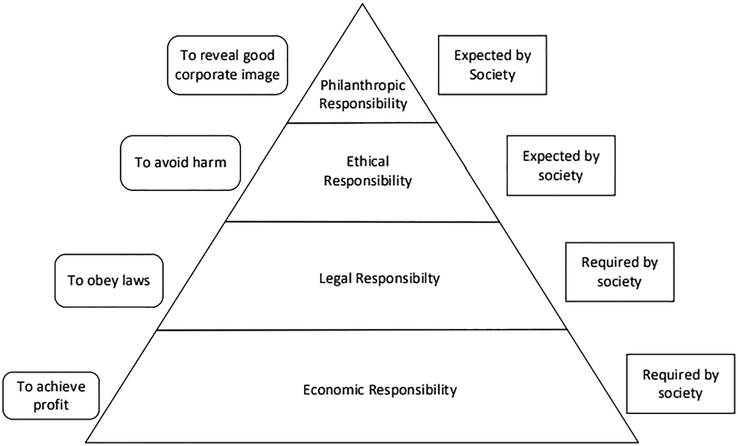
Carroll pyramid of CSR.
The main novel objectives of this study are: (1) To elucidate the effect of sewage drain (based on distance) on groundwater contamination. (2) To reveal biological contamination in groundwater affected by sewage drain, correlation with COVID-19 based on previous reviews, strategic management, and development to control waterborne diseases and pollution; (3) To check the biological parameters including E. coli, fecal and total coliform, BOD, COD mainly in groundwater; (4) To determine the microbial contamination causing the gastrointestinal problem. Besides, a glimpse of the role of CSR in preventing disease spread, practical strategies, insights regarding CSR, and why CSR is essential is also highlighted by examining the Covid-19 response behavior. This study will provide a possible and necessary framework for future studies primarily related to the pandemic, including COVID-19.
2 Material and methodology
2.1 Sampling sites
The groundwater samples were withdrawn from two different sewage drains (WASA drainage Chibban and drainage number-1) based on different distances like 0–5, 5–10, 10–15, 15–20 m. These drains are rich source of industrial (textile & tannery) and domestic effluent. These drains are a more vulnerable source of fecal matter, industrial effluent, and microbial pollutants. Although, we aimed that as we will move away from the drain, the contamination will be less. All the samples for physiochemical properties/analysis were placed in cool and dark places.
2.2 Biological analysis
Groundwater samples were drawn with sterilized syringes to prevent/avoid the bacterial and microbial contamination. Syringed water for the biological examination was reserved at very low temperatures to prevent the additional contamination. coliform count, E. coli, BOD, COD, and DO were determined. All the chemicals belonged to standard analytical grade bought from Merck Company (Darmstadt, Germany).
2.3 Physiochemical analysis
The basic physicochemical parameters including water pH, E.C, TSS, total hardness, chlorides, TDS, CO32−, HCO3−, calcium, magnesium, turbidity, sulphate, and nitrate were determined. All the experimental findings were performed in triplicate (Ahmed et al., 2015; Raza et al., 2017).
3 Results and discussion
3.1 Biological analysis
Biological analysis, especially E. coli, fecal count, and total coliform count, can be an appropriate choice to determine the microbial contamination of groundwater. This can interlink/predict the presence of COVID-19 in groundwater as it has evidence for the human to human, droplet transmission, and presence in the stool. The presence of stool and fecal matters are undeniable in a sewage drain, even can visualize by the naked eye. Thus, we selected different sampling sites in the vicinity of the sewage drain, because we think that as we will move away from the sewage drain, groundwater contamination will be decreased.
3.2 E. coli status
The E. coli status for all the groundwater samples was significant/positive, and according to WHO guidelines, such waters are not suitable for drinking purposes (WHO, 2011).
3.3 Total coliform count
Coliform/100 mL concentration of groundwater samples of drain-1 ranged from 22.75 to 48.66/100 mL (Fig. 2). The maximum mean value of 48.66 /100 mL was observed in samples collected at a 20–25 m distance from the drain, and the minimum value observed was 22.75/ 100 mL at 0–5 m distance from the drain. Meanwhile, the concentration of Coliform in drain-2, the Coliform ranged from 17.75 to 47/ 100 mL (Fig. 2). The highest mean value (47 /100 mL) was found in samples collected at 20–25 m distance from the drain-2, and the minimum value (17.75/100 mL) was found at 0–5 m distance from the drain-2.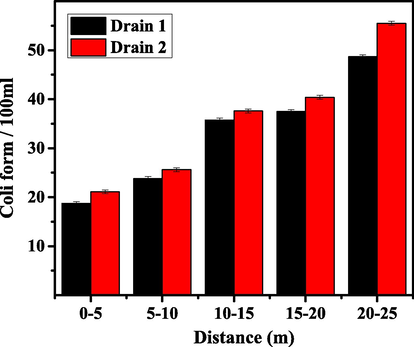
Coliform count in groundwater samples collected at different distances from drain 1 and Drain 2.
Comparison of both the drains indicated that the drain-2 has a significantly high coliform concentration as compared to drain-1, but both the drains were dirtied. The increased fecal adulteration of groundwater near drain ascribed to high recharge/contamination from the Paharang drain. In addition, the significant seepage/infiltration is also the reason for groundwater deterioration/ contamination (PCWR, 2006).
3.4 Dissolved oxygen (D.O.)
D.O also refers to dissolved, free, and non-bonded oxygen. It affects the life of microbes, and organisms existing in the water. The living organisms living in water consume it for their respiration. Besides, a very high and deficient level of oxygen is also harmful to water quality and aquatic life. The D.O. has a permissible range of 4 mgL−1 as per WHO guidelines (WHO, 2011).
The D.O. level in groundwater samples collected at different distances of drain-1 ranged from 3.10 to 3.28 mg L−1 (Fig. 3). The maximum mean value 3.28 mg L−1 was observed in samples collected from 0 to 5 m distance from the drain, while the minimum measured value was 3.10 mg L−1 at a 20–25 m distance from the drain.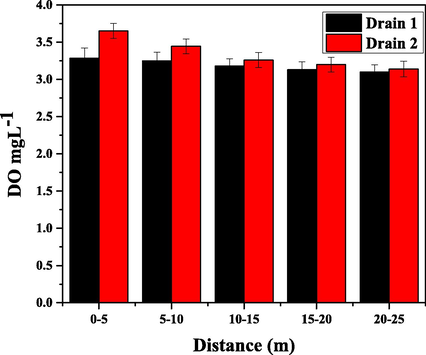
Dissolved oxygen in groundwater samples collected at different distances from drain-1 and drain-2.
Meanwhile, D.O. constituents in groundwater samples of drain-2 summarized from 3.14 to 3.65 mg L−1 (Fig. 3). The highest mean value was 3.65 mg L−1 in samples obtained at a 0–5 m distance from the drain, and the minimum value was 3.14 mg L−1 at a 20–25 m distance from the drain. Comparative study of both the drains imitated that drain-2 comprised higher D.O. level than drain-1 and the values of D.O. from both the drains remained within the permissible limits of WHO. Authors conclude that minimum values of D.O. in the summer season possibly due to the degradation rate of organic matter. Due to inadequate flow of water in a low holding environment due to high temperature (Gupta and Shrivastava, 2004).
3.5 Biological oxygen demand (BOD)
The required amount of D.O. needed for microbial decomposition/ degradation of organic constituents present under the water. The maximum extent of BOD is detrimental as it lessen the dissolved oxygen with the addition of algal bloom, and release of methane and ammonia in water. According to WHO, the acceptable range of BOD is up to 10 mg L−1.
BOD levels in groundwater samples of drain-1 ranged from 8 to 25.75 mg L−1 (Fig. 4). BOD values remained maximum (25.75 mg L−1) in samples collected at a 20–25 m distance from the drain, and the value was minimum (8 mg L−1) at a 0–5 m distance from the drain. Meanwhile, the BOD level present in groundwater samples of drain-2 ranged from 6.25 to 21.5 mg L−1 (Fig. 4). The mean BOD value was maximum (21.5 mg L−1) at a 20–25 m distance from the drain, and the minimum lowest amount was 6.25 mg L−1 at 0–5 m distance.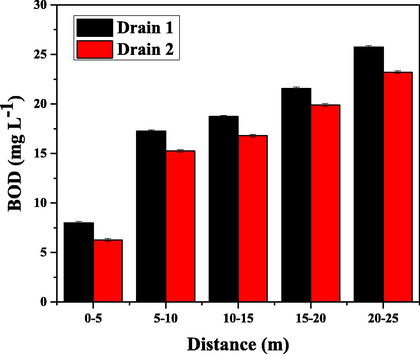
Biological oxygen demand in groundwater samples collected at different distances from drain 2.
Evaluation of both the drains revealed that the drain-1 has a significantly advanced, and greater value of BOD than drain-2. But BOD values from both drains were not within the allowable limits of WHO (Hamill and Bell, 2013).
3.6 Chemical oxygen demand (COD)
The quantity and level of oxygen required to oxidized organic matter available in groundwater. COD is correlated with BOD, as BOD directly rely on COD. If the COD concentration will high, it will directly influence living biota. The acceptable range is lye up to 10 mg L−1, as per WHO guidelines.
COD levels in groundwater samples of drain-1 ranged from 18.75 to 49.20 mg L−1 (Fig. 5). The mean COD value was a maximum of 49.20 mg L−1 in samples collected 20–25 m distance from the drain, and the minimum value was 18.75 mg L−1 at 0–5 m distance from the drain. Meanwhile, COD concentration in groundwater samples of drain-2 valued from 15.45 to 46.58 mg L−1 (Fig. 5). Mean COD value was maximum (46.58 mg L−1) in samples obtained at a 20–25 m distance from the drain and remained minimum (15.45 mg L−1) at a 0–5 m distance from the drain. Comparative of both the drains reflected that drain-1 has a higher COD level than drain-2, but values remained within the acceptable restrictions of WHO.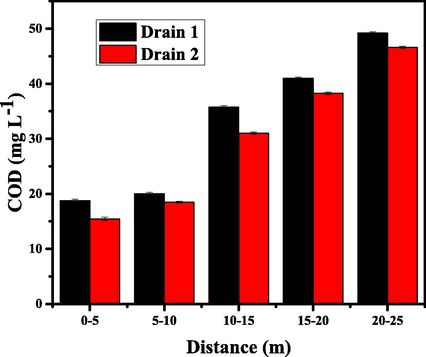
Chemical oxygen demand in groundwater samples collected at different distances from drain 1 and drain 2.
3.7 Chemical analysis
The overall pH of groundwater ranged from 7.44 to 7.73 at different distances from the drain-1. For drain-2, the highest value was 7.92 at 0–5 m, and the lower was 7.34 at a 20–25 m distance from drain. The figures of all samples existed within the allowable limit of WHO. The E.C. of drain-1 groundwater samples ranged from 3.10 to 3.92 dSm−1. The maximum value was 3.92 dSm−1 at 0–5 m, and the lowest was 3.10 dSm−1 at 20–25 m distance from the drain. On the other hand, E.C. of drain-2 groundwater samples ranged 2.85–5.21 dSm−1. The maximum value was 5.21 dSm−1 at 0–5 m distance from the drain, while the minimum value was 2.85 dSm−1 at a 20–25 m far from the drain. The concentration of both the drains were out of the acceptable limit of WHO.
The concentration of TSS in drain-1 groundwater samples ranged from 1988.8 to 2512 mg L−1 and maximum value was 2512 mg L−1 at 0–5 m, and the minimum was 1988.8 mg L−1 at 20–25 m away from drain-1. Meanwhile, TSS of drain-2, groundwater samples ranged 1828.8–3336 mg L−1 and remained extreme 3336 mg L−1 at a 0–5 m distance from the drain and least value 1828.8 mg L−1 at 20–25 m from the drain. The TSS values of both drains were above the allowable limit of WHO. The numeric values of TDS in Drain-1 groundwater samples ranged from 2.25 to 2.46 ppt, and the maximum value was 2.46 ppt at 0–5 m, and the minimum was 2.25 ppt at a 20–25 m far from drain-1. While TDS of drain-2 groundwater samples ranged 2.1–2.8 ppt and supreme value 2.8 ppt at 0–5 m and tiniest value 2.1 ppt was 20–25 m. The TSS values of both drains were above the permissible limit of WHO.
The turbidity of all the samples was zero. The concentration of total hardness in Drain-1 groundwater samples ranged from 63.75 to 102 mgL−1 and showed a maximum value of 102 mgL−1 at 0–5 m, and the minimum was 63.75 mgL−1 at a 20–25 m distance from drain-1. In comparison, drain-2 groundwater samples ranged 57.25–108 mg L−1 and showed maximum value 108 mg L−1 at 0–5 m and minimum value of 57.25 mgL−1 at 20–25 m. The values of both drains were within the permissible limit of WHO.
The chloride contents of groundwater samples of drain-1 ranged from 713.25 to 1327 mgL−1 and showed extreme value 1327 mgL−1 at 0–5 m, and the minimum value was 713.25 mgL−1 at a 20–25 m distance from drain-1. While drain-2 groundwater data ranged 716.5–1662.3 mgL−1 and maximum value 1662.3 mg L−1 at 0–5 m and minimum value 716.5 mgL−1 was at 20–25 m. Water samples data at 0–5 m from the both drains were not within the permissible limit of WHO. Meanwhile, the concentration of calcium in drain-1 groundwater samples ranged from 21.4 to 54.92 mgL−1, and extreme value 54.92 mgL−1 at a 0–5 m, and the smallest value was 21.4 mgL−1 at a 20–25 m distance from drain-1. While drain-2 groundwater samples ranged 24.04–57.43 mgL−1 and the maximum amount 57.43 mgL−1 at 0–5 m and the minimum value 24.04 mgL−1 was at 20–25 m. The calcium values of both drains were above the allowed limit of WHO. Meanwhile, the concentration of magnesium of drain-1 groundwater ranged from 43.75 to 64.5 mgL−1. The extreme value was 64.5 at 0–5 m, and the minimum value was 43.75 mg L−1 at a 20–25 m distance from drain-1. While drain-2 groundwater samples ranged 36–73.5 mg L−1 and the highest value was 73.5 mgL−1 at 0–5 m, and minimum value 36 mgL−1 was 20–25 m. The magnesium concentration of both drains was within the permissible limit of WHO (Table 1).
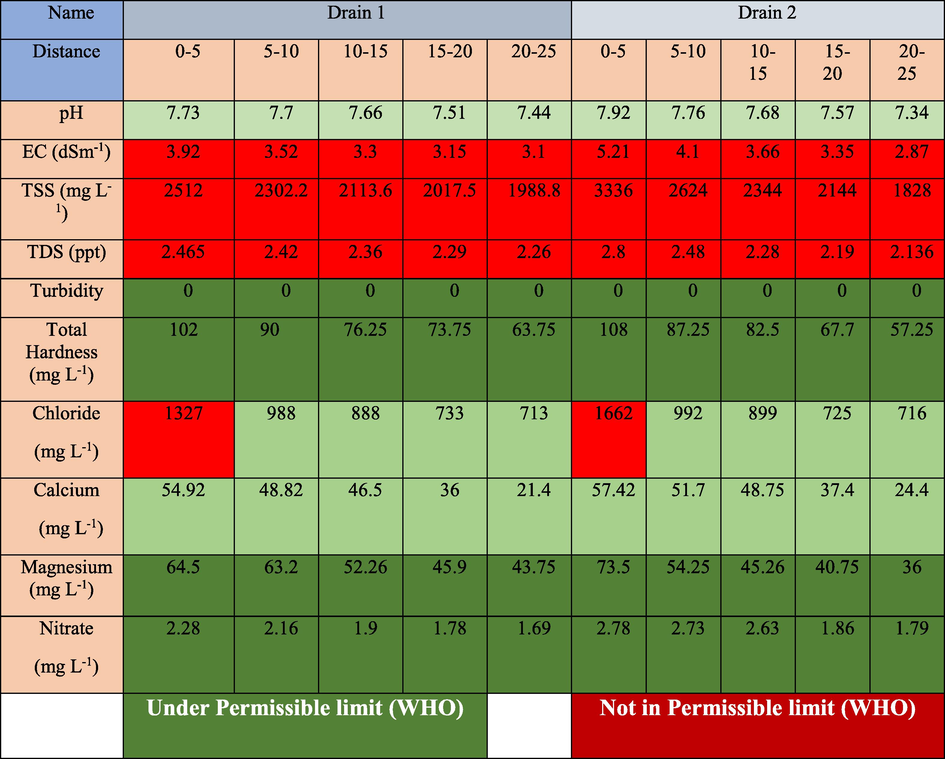
The concentration of magnesium of drain-1 groundwater ranged from 43.75 to 64.5 mgL−1. The maximum value was 64.5 at 0–5 m, and the minimum value was 43.75 mg L−1 at a 20–25 m distance from drain-1. While drain-2 groundwater samples ranged 36–73.5 mg L−1 and the maximum value was 73.5 mgL−1 at 0–5 m, and minimum value 36 mgL−1 was 20–25 m. The magnesium concentration of both drains was within the permissible limit of WHO.
The concentration of nitrate in groundwater samples of drain-1 ranged from 1.69 to 2.28 mgL−1, and the maximum value was 2.28 at 0–5 m, and the minimum value was 1.69 mgL−1 at a 20–25 m distance from drain-1. While drain-2 groundwater samples ranged 1.79–2.78 mgL−1 and the maximum value was 2.78 mgL−1 at 0–5 m, and the minimum value 1.79 mgL−1 was at 20–25 m. The nitrate concentration of both drains was within the permissible limit of WHO.
3.8 Covid in feces
Many studies are reporting the presence of COVID in fecal waste (stool) given in the Table 2. The presence of the virus in stool may lead to entry into the human body by consuming contaminated water. This may have a drastic effect on the global world.
Authors
Location
Sample Size
Technique
Positive sample
Virus sustainability in stool (days)
Ling et al 2020 (Ling et al., 2020)
Shanghai, China
55
RT-PCR
16.7%
Leung et al 2003 (Leung et al., 2003)
Hongkong
138
Serology & RT-PCR
16%
73
Xu et al 2020 (Xu et al., 2020)
Guangzhou, China
10
RT-PCR of rectal swab
80%
Holshue et al 2020 (Holshue et al., 2020)
United States
1
Rt-PCR
100%
7
Tian et al 2020 (Tian et al., 2020)
73
Faecal PCR
53%
11
Chen et al 2020 (Chen et al., 2020)
Zhejiang, China
22
QRT-PCR
16%
10
Zhang et al 2020 (Zhang et al., 2020)
Zhejiang, China
14
RT-PCR
35.6%
15
4 Conclusion
A study was directed to assess the effects of sewage drains on biological and physiochemical parameters of groundwater located at different distances (0–5 m, 5–10 m, 10–15 m, 15–20 m, 20–25 m) from the drains. Because we may hypothesize that away from the drain, less will contaminate. The effect of sewage drains on groundwater contamination is very obvious according to results.
E. coli results for all the groundwater samples were positive. E. coli status was above the permissible limit of WHO. The maximum values were observed near to the drain (48.66/ 1000 mL & distance (0–5 m). The presence of E. coli force to think that if it can contaminate and present in a significant amount, then emerging/concerning COVID can also penetrate to groundwater.
In addition, previous significant studies reported that COVID-19 is present in stool, and the presence of stool in sewage drain is undeniable, and even can be seen by the naked eye. It may threaten to ground health ultimately to living biota, including humans. Our previous results, like E. coli and coliform count, advocate the presence of biological contamination.
The D.O. concentration of groundwater samples of both drains was within the permissible limit of WHO (3.10–3.28 mg L−1 & 3.04–3.43 mg L−1, respectively). The BOD level in groundwater samples of drain-1 and drain-2 ranged from 8 to 25.75 mgL−1 and 6.25–21.5 mgL−1, respectively. Similarly, the COD level in groundwater samples of both drains ranged 18.75–48.75 mgL−1, and 20.75–51.25 mgL−1, and the maximum value was observed near to drain. The COD concentration of both the drains was within the permissible limit of WHO. Most of the chemical parameters were above the permissible limit given by WHO, including TSS, TDS, chloride, calcium. The excess of these parameters with influential contamination of groundwater may lead to drastic effects on human health. If the biological parameters can exist in groundwater, then we can alarm future biological pandemics, including COVID-19, as they can enter into groundwater.
In the light of Carroll's pyramid theory concluded that CSR could play a vital role in dealing with and concerning groundwater contamination, because it's an economic, legal, ethical, and philanthropic responsibility of every organization. Moreover, to discuss in more detail and understand the inescapable importance of corporate social responsibility in crisis management, the COVID-19 pandemic threatens life and livelihoods worldwide. In seven months, over seven million people have died due to infectious diseases around the globe, while the United Nations called this world's most daunting situation since the second world war has caused at least 50,000 deaths in an emergency in public health (Holmes et al., 2017). The responses of organizations and their role in containing the spread of this virus through groundwater must need to gain importance. Scientists and policy experts have been studying for years how countries plan for and respond to pandemics. It is clear; they believe: CSR has a tangible impact on the efficacy of the pandemic response on policy and communications choices. However, it is an undeniable fact that the majority of the organizations failed miserably in playing their role to control the Covid-19 spread. It is vital to keep an eye on the reach of this virus through groundwater, and companies and organizations must need to play their role to sort out this issue on a priority basis.
Germany and New Zealand, in particular, have successfully handled the crisis. Both nations did not wave from a scientific approach and from solid, unified contact. On January 27, Germany found out its first cases. Around the time, the minister of health found COVID-19 a low threat. (Blackburn and Ruyle, 2020). New research kits were available within a month and the laboratories in Germany already stored. By mid-March, schools and retail companies had shut down the region. The training was rapidly carried out, and Germany conducted more than 100,000 tests a week within just two weeks. The United States had surveyed around 5000 people during that same time frame and had not achieved figures close to Germany until some weeks later. Chancellor Angela Merkel led the concerted response from Germany, which included the early and wide-ranging testing along with social distancing policies. All didn't go smoothly. Higher health care providers also have, in many cases, flexibility, leading to a degree of discontinuity in policy implementation across countries. Yet, most Germans actively adopted the national government's policies. Now, Germany's constraints are being removed.
The second country to successfully handle the crisis is New Zealand; now, they have zero new cases. New Zealand has examined approximately 175,000 infected people. (Blackburn and Ruyle, 2020). On the other hand, some countries have adopted the hands-off approach rather than hands wash approach. Brazil has described more than 330,000 cases and 107,800 deaths from COVID-19. It is the third-largest outbreak in the world, behind only the U.S. and Russia. Leaders of both Brazil and Nicaragua have adopted a “hands-off” policy in many cases, even discouraging inhabitants from following public health procedures taken in other countries.
The Table 3 shows the data regarding the first confirmed reported cases and the current number of confirmed cases in a few countries. As discussed in the Table 3, a few countries which implanted and taken strict prompt actions controlled the situation successfully. For example, China, with such a massive population of 1.44 Billion, limited their confirmed cases at only 0.0060 of her total population. It is then followed by New Zealand which limits the confirmed cases at only 0.0242 of her total population. Even though China is way too efficient in controlling the spread of the virus, however, New Zealand did this as well effectively. As we can see in the Table 3 above, none of the countries was able to control the situation except China and New Zealand.
Sr.No
Country
Total Population
First confirmed case
Confirmed number of cases reported
Reported Deaths
Confirmed cases % of total population
Response
1
China
1,493,323,776
22nd January 2020
84,849
4,634
0.0060
Strict Lockdown and massive testing
2
Brazil
212,751,912
27th February 2020
33,40,197
107,879
0.7346
Taken for granted in early days, considered it as normal flu, no prompt actions taken.
3
Germany
83,817,100
29th January 2020
2,24,997
9290
0.2370
Strict Lockdown and massive testing
4
India
1,381,715
30thJanuary 2020
26,51,290
51,079
0.0462
Followed strict lockdown but failed to continue it further.
5
Pakistan
221,401,496
27th February 2020
228,716
6,168
0.1046
No obvious care at the start, less number of tests per day. After gigantic cases, Smart lockdown strategy was imposed
6
Iran
81.800,000
30th January 2020
26,51,290
51,079
0.2878
Strict Lockdown but mismanaged the isolation centers in initial days.
7
New Zealand
4,886,000
27th February 2020
228,716
6168
0.0242
Strict Lockdown and massive testing, closed borders immediately.
As per WHO procedures for groundwater quality standard, groundwater of Faisalabad Punjab, especially area closer to drains, is unfit, un-hygienic for health, and not appropriate for healthy life, especially when it comes for drinking purposes. E. coli and coliform count are very obvious in groundwater. The evidence and presence of COVID-19 in stool is an alarming and emerging challenge to clean or remediate groundwater pollution. It is evident from this study that the groundwater contamination could be a new way to spread the COVID-19 and with the introduction of numerous other ways the CSR of different companies and organizations is to implement water treatment plant and other innovative tactics and methodologies to prevent this cause from happening (Lambooy, 2011). Without these kinds of prevention techniques and methodologies, we will be unable to cop up not only with COVID-19 but many other hidden diseases which require our serious attention to follow innovative procedures (Flammer, 2013). It is apparent from the previous literature that the Carrolls pyramid of CSR could be a new way to stop the spread of COVID-19 through groundwater contamination.
5 Limitations of the study
This study has significant contribution to control the COVID-19 and future pandemics. There are number of further studies can be conducted like detection of COVID-19 by techniques mentioned in Table 2. The systematic layout can be proposed to avoid the spread of WBDs in poor and developing countries.
Acknowledgements
This research was conducted under the shadow of University of Agriculture, Faisalabad, Pakistan. The authors would like to extend their sincere appreciation to the acknowledgment; research supporting project (RSP-2020/95, King Saud University, Riyadh, Saudi Arabia).
Declaration of Competing Interest
The authors declare that they have no known competing financial interests or personal relationships that could have appeared to influence the work reported in this paper.
References
- Assessment of drinking water quality and its potential health impacts in academic institutions of Abbottabad (Pakistan) Desalin. Water Treat.. 2015;54(7):1819-1828.
- [Google Scholar]
- Global assessment of exposure to faecal contamination through drinking water based on a systematic review. Trop. Med. Int. Health. 2014;19(8):917-927.
- [Google Scholar]
- How Leadership in Various Countries Has Affected COVID-19 Response Effectiveness. The 2020 Conversation
- [Google Scholar]
- Chen, J., Zhu, H., Wang, D., Zheng, Y., Xu, J., Zhu, G., et al., 2020. Clinical features of stool SARS-CoV-2 RNA positive in 137 COVID-19 patients in Taizhou, China.
- Ozonation of pentabromophenol in aqueous basic medium: Kinetics, pathways, mechanism, dimerization and toxicity assessment. Chemosphere. 2019;220:546-555.
- [Google Scholar]
- What are the main factors influencing the presence of faecal bacteria pollution in groundwater systems in developing countries? J. Contam. Hydrol.. 2020;228:103556.
- [Google Scholar]
- Corporate social responsibility and shareholder reaction: The environmental awareness of investors. Acad. Manag. J.. 2013;56(3):758-781.
- [Google Scholar]
- Pakistan integrated household survey. Pakistan: Government of Pakistan; 2000.
- Studies on water quality assessment in Satna city(M. P.): Seasonal parametric variations. Nat. Environ. Pollut. Technol.. 2004;3(4):563-565.
- [Google Scholar]
- Groundwater resource development. Elsevier; 2013.
- COVID-19 Epidemic Spread and the Impact on Public Health & Safety Policy: An Analysis of the Adoption of Preventive Measures and Effective Management: Evidence from Pakistan. Revista Argentina de Clínica Psicológica. 2020;29(4):722-736.
- [Google Scholar]
- The emerging pandemic of coronavirus and the urgent need for public health leadership. Am. J. Med.. 2020;133(6):648-650.
- [Google Scholar]
- Holmes, K.K., Bertozzi, S., Bloom, B.R., Jha, P., Gelband, H., DeMaria, L.M., Horton, S., 2017. Major infectious diseases: key messages from disease control priorities.
- First case of 2019 novel coronavirus in the United States. N. Engl. J. Med.. 2020;382(10):929-936.
- [Google Scholar]
- Jehangir, W.A., Mudasser, M., Ali, N., 2000. Domestic uses of irrigation water and its impact on human and livestock health in Pakistan. Paper presented at the Challenges facing irrigation and drainage in the new millennium., Proceedings US Committee on Irrigation and Drainage, Fort Collins, Colorado, USA, June 2000.
- Corporate social responsibility: sustainable water use. J. Cleaner Prod.. 2011;19(8):852-866.
- [Google Scholar]
- Enteric involvement of severe acute respiratory syndrome-associated coronavirus infection. Gastroenterology. 2003;125(4):1011-1017.
- [Google Scholar]
- Persistence and clearance of viral RNA in 2019 novel coronavirus disease rehabilitation patients. Chin. Med. J.. 2020;133(9):1039-1043.
- [Google Scholar]
- A systematic review of waterborne disease burden methodologies from developed countries. J. Water Health. 2014;12(4):634-655.
- [Google Scholar]
- Nawaz, A., Su, X., Iqbal, S., Zahoor, H., Asad, A., Asghar, S., et al., 2020. Validating a Phenomenological Mathematical Model for Public Health and Safety Interventions Influencing the Evolutionary Stages of Recent Outbreak for Long-Term and Short-Term Domains in Pakistan. Complexity, 2020.
- Tryptophan-like fluorescence as a measure of microbial contamination risk in groundwater. Sci. Total Environ.. 2019;646:782-791.
- [Google Scholar]
- Strategic corporate social responsibility and environmental sustainability. Business & society. 2011;50(1):6-27.
- [Google Scholar]
- PCWR, 2006. Annual report part 2. Retrieved from Islamabad, Pakistan:
- Green governance: Boards of directors’ composition and environmental corporate social responsibility. Business & society. 2011;50(1):189-223.
- [Google Scholar]
- Preventing disease through healthy environments: a global assessment of the burden of disease from environmental risks. World Health Organization; 2016.
- COVID-19: The environmental implications of shedding SARS-CoV-2 in human faeces. Environment. 2020;140:105790.
- [Google Scholar]
- Groundwater status in Pakistan: A review of contamination, health risks, and potential needs. Crit. Rev. Environ. Sci. Tech.. 2017;47(18):1713-1762.
- [Google Scholar]
- Schwartz, M.S., 1997. Carroll's pyramid of corporate social responsibility: A new approach. Paper presented at the Proceedings of the International Association for Business and Society.
- Understanding the ozonated degradation of sulfadimethoxine, exploration of reaction site, and classification of degradation products. Chemosphere. 2018;212:228-236.
- [Google Scholar]
- Board attributes, corporate social responsibility strategy, and corporate environmental and social performance. J. Bus. Ethics. 2016;135(3):569-585.
- [Google Scholar]
- Industrial/environmental crises and corporate social responsibility. J. Socio-Econom.. 1995;24(1):211-227.
- [Google Scholar]
- gastrointestinal features in COVID-19 and the possibility of faecal transmission. Aliment. Pharmacol. Ther.. 2020;51(9):843-851.
- [Google Scholar]
- An investigation on treatment of groundwater with cold plasma for domestic water supply. Groundwater Sustainable Dev.. 2020;10:100309.
- [Google Scholar]
- Strategic corporate social responsibility: Stakeholders in a global environment. Sage; 2010.
- WHO, 2011. Guidlines for drinking-water quality.
- WHO, 2015. Estimates of the Global Burden of Foodborne Diseases. from World Health Organization http://www.who.int/foodsafety/publications/foodborne_disease/fergreport/en/
- Characteristics of pediatric SARS-CoV-2 infection and potential evidence for persistent fecal viral shedding. Nat. Med.. 2020;26(4):502-505.
- [Google Scholar]
- Fecal specimen diagnosis 2019 novel coronavirus–infected pneumonia. J. Med. Virol.. 2020;92(6):680-682.
- [Google Scholar]







